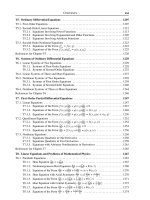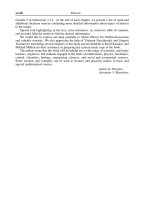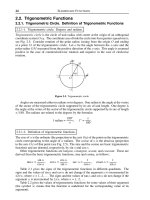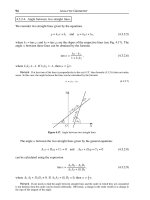Handbook of mathematics for engineers and scienteists part 41 pot
Bạn đang xem bản rút gọn của tài liệu. Xem và tải ngay bản đầy đủ của tài liệu tại đây (476.06 KB, 7 trang )
248 LIMITS AND DERIVATIVES
3. Let f (x)beafunctiononafinite segment [a, b] satisfying the Lipschitz condition
f(x
1
)–f(x
2
)
≤ L|x
1
– x
2
|,
for any x
1
and x
2
in [a, b], where L is a constant. Then f(x) has bounded variation and
b
V
a
f(x) ≤ L(b – a).
4. Let f(x)beafunctiononafinite segment [a, b] with a bounded derivative |f
(x)| ≤ L,
where L = const. Then, f(x) is of bounded variation and
b
V
a
f(x) ≤ L(b – a).
5. Let f(x)beafunctionon[a, b]or[a, ∞) and suppose that f(x) can be represented
as an integral with variable upper limit,
f(x)=c +
x
a
ϕ(t) dt,
where ϕ(t) is an absolutely continuous function on the interval under consideration. Then
f(x) has bounded variation and
b
V
a
f(x)=
b
a
|ϕ(x)| dx.
C
OROLLARY.
Suppose that
ϕ(t)
on a finite segment
[a, b]
or
[a, ∞)
is integrable, but
not absolutely integrable. Then the total variation of
f(x)
is infinite.
6.1.7-3. Properties of functions of bounded variation.
Here, all functions are considered on a finite segment [a, b].
1. Any function of bounded variation is bounded.
2. The sum, difference, or product of finitely many functions of bounded variation is a
function of bounded variation.
3. Let f(x)andg(x) be two functions of bounded variation and |g(x)| ≥ K > 0.Then
the ratio f (x)/g(x) is a function of bounded variation.
4. Let a < c < b.Iff(x) has bounded variation on the segment [a, b], then it has bounded
variation on each segment [a, c]and[c, b]; and the converse statement is true. In this case,
the following additivity condition holds:
b
V
a
f(x)=
c
V
a
f(x)+
b
V
c
f(x).
5. Let f(x) be a function of bounded variation of the segment [a, b]. Then, for a ≤ x ≤ b,
the variation of f (x) with variable upper limit
F (x)=
x
V
a
f(x)
is a monotonically increasing bounded function of x.
6. Any function f (x) of bounded variation on the segment [a, b] has a left-hand limit
lim
x→x
0
–0
f(x) and a right-hand limit lim
x→x
0
+0
f(x) at any point x
0
[a, b].
6.1. BASIC CONCEPTS OF MAT H E M AT I CAL ANALYSIS 249
6.1.7-4. Criteria for functions to have bounded variation.
1. A function f(x) has bounded variation on a finite segment [a, b] if and only if there is
a monotonically increasing bounded function Φ(x) such that for all x
1
, x
2
[a, b](x
1
< x
2
),
the following inequality holds:
|f(x
2
)–f(x
1
)| ≤ Φ(x
2
)–Φ(x
1
).
2. A function f(x) has bounded variation on a finite segment [a, b] if and only if f(x)
can be represented as the difference of two monotonically increasing bounded functions on
that segment: f(x)=g
2
(x)–g
1
(x).
Remark. The above criteria are valid also for infinite intervals (–∞, a], [a, ∞), and (–∞, ∞).
6.1.7-5. Properties of continuous functions of bounded variation.
1. Let f(x) be a function of bounded variation on the segment [a, b]. If f (x)is
continuous at a point x
0
(a < x
0
< b), then the function F (x)=
x
V
a
f(x) is also continuous
at that point.
2. A continuous function of bounded variation can be represented as the difference of
two continuous increasing functions.
3. Let f(x) be a continuous function on the segment [a, b]. Consider a partition of the
segment
a = x
0
< x
1
< x
2
< ··· < x
n–1
< x
n
= b
and the sum v =
n–1
k=0
f(x
k+1
)–f(x
k
)
. Letting λ =max|x
k+1
– x
k
| and passing to the limit
as λ → 0,weget
lim
λ→0
v =
b
V
a
f(x).
6.1.8. Convergence of Functions
6.1.8-1. Pointwise, uniform, and nonuniform convergence of functions.
Let {f
n
(x)} be a sequence of functions defined on a set X ⊂R. The sequence {f
n
(x)} is said
to be pointwise convergent to f(x)asn →∞if for any fixed x X, the numerical sequence
{f
n
(x)} converges to f(x). The sequence {f
n
(x)} is said to be uniformly convergent to a
function f(x)onX as n →∞if for any ε > 0 there is an integer N = N(ε) and such that
for all n > N and all x
X, the following inequality holds:
|f
n
(x)–f(x)| < ε.(6.1.8.1)
Note that in this definition, N is independent of x. For a sequence {f
n
(x)} pointwise
convergent to f (x)asn →∞,bydefinition, for any ε > 0 and any x X,thereis
N = N(ε, x) such that (6.1.8.1) holds for all n > N(ε, x). If one cannot find such N
independent of x and depending only on ε (i.e., one cannot ensure (6.1.8.1) uniformly; to be
more precise, there is δ > 0 such that for any N > 0 there is k
N
> N and x
N
X such that
|f
k
N
(x
N
)–f(x
N
)| ≥ δ), then one says that the sequence {f
n
(x)} converges nonuniformly
to f(x)onthesetX.
250 LIMITS AND DERIVATIVES
6.1.8-2. Basic theorems.
Let X be an interval on the real axis.
T
HEOREM.
Let
f
n
(x)
be a sequence of continuous functions uniformly convergent to
f(x)
on
X
.Then
f(x)
is continuous on
X
.
COROLLARY.
If the limit function
f(x)
of a pointwise convergent sequence of contin-
uous functions
{f
n
(x)}
is discontinuous, then the convergence of the sequence
{f
n
(x)}
is
nonuniform.
Example. The sequence {f
n
(x)} = {x
n
} converges to f (x) ≡ 0 as n →∞uniformly on each segment
[0, a], 0 < a < 1. However, on the segment [0, 1] this sequence converges nonuniformly to the discontinuous
function f(x)=
0 for 0 ≤ x < 1,
1 for x = 1.
CAUCHY CRITERION.
A sequence of functions
{f
n
(x)}
defined on a set
X R
uniformly
converges to
f(x)
as
n →∞
if and only if for any
ε > 0
there is an integer
N = N(ε)>0
such that for all
n > N
and
m > N
, the inequality
|f
n
(x)–f
m
(x)| < ε
holds for all
x X
.
6.1.8-3. Geometrical meaning of uniform convergence.
Let f
n
(x) be continuous functions on the segment [a, b] and suppose that {f
n
(x)} uniformly
converges to a continuous function f(x)asn →∞. Then all curves y =f
n
(x), for sufficiently
large n > N , belong to the strip between the two curves y = f (x)–ε and y = f(x)+ε (see
Fig. 6.3).
O
x
y
ba
yfx= ()
yfx= ()+ε
yfx=-() ε
yfx= ()
n
Figure 6.3. Geometrical meaning of uniform convergence of a sequence of functions {f
n
(x)} to a continuous
function f (x).
6.2. Differential Calculus for Functions of a Single
Variable
6.2.1. Derivative and Differential, Their Geometrical and Physical
Meaning
6.2.1-1. Definition of derivative and differential.
The derivative of a function y = f(x) at a point x is the limit of the ratio
y
= lim
Δx→0
Δy
Δx
= lim
Δx→0
f(x + Δx)–f (x)
Δx
,
where Δy = f(x+Δx)–f(x) is the increment of the function corresponding to the increment
of the argument Δx. The derivative y
is also denoted by y
x
, ˙y,
dy
dx
, f
(x),
df (x)
dx
.
6.2. DIFFERENTIAL CALCULUS FOR FUNCTIONS OF A SINGLE VARIABLE 251
Example 1. Let us calculate the derivative of the function f(x)=x
2
.
By definition, we have
f
(x) = lim
Δx→0
(x + Δx)
2
– x
2
Δx
= lim
Δx→0
(2x + Δx)=2x.
The increment Δx is also called the differential of the independent variable x and is
denoted by dx.
A function f (x) that has a derivative at a point x is called differentiable at that point.
The differentiability of f (x) at a point x is equivalent to the condition that the increment
of the function, Δy = f(x + dx)–f(x), at that point can be represented in the form
Δy = f
(x) dx + o(dx) (the second term is an infinitely small quantity compared with dx as
dx → 0).
A function differentiable at some point x is continuous at that point. The converse is
not true, in general; continuity does not always imply differentiability.
A function f (x) is called differentiable on a set D (interval, segment, etc.) if for any
x
D there exists the derivative f
(x). A function f(x) is called continuously differentiable
on D if it has the derivative f
(x) at each point x D and f
(x) is a continuous function on
D.
The differential dy of a function y = f(x) is the principal part of its increment Δy at the
point x,sothat dy = f
(x)dx, Δy = dy + o(dx).
The approximate relation Δy ≈ dy or f (x + Δx) ≈ f(x)+f
(x)Δx (for small Δx)is
often used in numerical analysis.
6.2.1-2. Physical and geometrical meaning of the derivative. Tangent line.
1
◦
.Lety = f(x) be the function describing the path y traversed by a body by the time x.
Then the derivative f
(x) is the velocity of the body at the instant x.
2
◦
.Thetangent line or simply the tangent to the graph of the function y = f (x) at a point
M(x
0
, y
0
), where y
0
= f(x
0
), is defined as the straight line determined by the limit position
of the secant MN as the point N tends to M along the graph. If α is the angle between
the x-axis and the tangent line, then f
(x
0
)=tanα is the slope ratio of the tangential line
(Fig. 6.4).
O
x
y
y
dy
M
N
α
α
Δy
0
yfx= ()
x
0
x+ xΔ
0
Figure 6.4. The tangent to the graph of a function y = f(x) at a point (x
0
, y
0
).
Equation of the tangent line to the graph of a function y = f (x) at a point (x
0
, y
0
):
y – y
0
= f
(x
0
)(x – x
0
).
252 LIMITS AND DERIVATIVES
Equation of the normal to the graph of a function y = f(x) at a point (x
0
, y
0
):
y – y
0
=–
1
f
(x
0
)
(x – x
0
).
6.2.1-3. One-sided derivatives.
One-sided derivatives are defined as follows:
f
+
(x) = lim
Δx→+0
Δy
Δx
= lim
Δx→+0
f(x + Δx)–f (x)
Δx
right-hand derivative,
f
–
(x) = lim
Δx→–0
Δy
Δx
= lim
Δx→–0
f(x + Δx)–f(x)
Δx
left-hand derivative.
Example 2. The function y = |x| at the point x = 0 has different one-sided derivatives: y
+
(0)=1, y
–
(0)=–1,
but has no derivative at that point. Such points are called angular points.
Suppose that a function y = f(x) is continuous at x = x
0
and has equal one-sided
derivatives at that point, y
+
(x
0
)=y
–
(x
0
)=a. Then this function has a derivative at x = x
0
and y
(x
0
)=a.
6.2.2. Table of Derivatives and Differentiation Rules
The derivative of any elementary function can be calculated with the help of derivatives of
basic elementary functions and differentiation rules.
6.2.2-1. Table of derivatives of basic elementary functions (a = const).
(a)
= 0,(x
a
)
= ax
a–1
,
(e
x
)
= e
x
,(a
x
)
= a
x
ln a,
(ln x)
=
1
x
,(log
a
x)
=
1
x ln a
,
(sin x)
=cosx,(cosx)
=–sinx,
(tan x)
=
1
cos
2
x
,(cotx)
=–
1
sin
2
x
,
(arcsin x)
=
1
√
1 – x
2
, (arccos x)
=–
1
√
1 – x
2
,
(arctan x)
=
1
1 + x
2
, (arccot x)
=–
1
1 + x
2
,
(sinh x)
=coshx,(coshx)
=sinhx,
(tanh x)
=
1
cosh
2
x
,(cothx)
=–
1
sinh
2
x
,
(arcsinh x)
=
1
√
1 + x
2
, (arccosh x)
=
1
√
x
2
– 1
,
(arctanh x)
=
1
1 – x
2
, (arccoth x)
=
1
x
2
– 1
.
6.2. DIFFERENTIAL CALCULUS FOR FUNCTIONS OF A SINGLE VARIABLE 253
6.2.2-2. Differentiation rules.
1. Derivative of a sum (difference) of functions:
[u(x)
v(x)]
= u
(x) v
(x).
2. Derivative of the product of a function and a constant:
[au(x)]
= au
(x)(a = const).
3. Derivative of a product of functions:
[u(x)v(x)]
= u
(x)v(x)+u(x)v
(x).
4. Derivative of a ratio of functions:
u(x)
v(x)
=
u
(x)v(x)–u(x)v
(x)
v
2
(x)
.
5. Derivative of a composite function:
f(u(x))
= f
u
(u)u
(x).
6. Derivative of a parametrically defined function x = x(t), y = y(t):
y
x
=
y
t
x
t
.
7. Derivative of an implicit function defined by the equation F (x, y)=0:
y
x
=–
F
x
F
y
(F
x
and F
y
are partial derivatives).
8. Derivative of the inverse function x = x(y) (for details see footnote*):
x
y
=
1
y
x
.
9. Derivative of a composite exponential function:
[u(x)
v(x)
]
= u
v
ln u ⋅ v
+ vu
v–1
u
.
10. Derivative of a composite function of two arguments:
[f(u(x), v(x))]
= f
u
(u, v)u
+ f
v
(u, v)v
(f
u
and f
v
are partial derivatives).
Example 1. Let us calculate the derivative of the function
x
2
2x + 1
.
Using the rule of differentiating the ratio of two functions, we obtain
x
2
2x + 1
=
(x
2
)
(2x + 1)–x
2
(2x + 1)
(2x + 1)
2
=
2x(2x + 1)–2x
2
(2x + 1)
2
=
2x
2
+ 2x
(2x + 1)
2
.
Example 2. Let us calculate the derivative of the function ln cos x.
Using the rule of differentiating composite functions and the formula for the logarithmic derivative from
Paragraph 6.2.2-1, we get
(ln cos x)
=
1
cos x
(cos x)
=–tanx.
Example 3. Let us calculate the derivative of the function x
x
. Using the rule of differentiating the
composite exponential function with u(x)=v(x)=x,wehave
(x
x
)
= x
x
ln x + xx
x–1
= x
x
(ln x + 1).
*Lety = f(x) be a differentiable monotone function on the interval (a, b)andf
(x
0
) ≠ 0,wherex
0
(a, b).
Then the inverse function x = g(y) is differentiable at the point y
0
= f(x
0
)and g
(y
0
)=
1
f
(x
0
)
.
254 LIMITS AND DERIVATIVES
6.2.3. Theorems about Differentiable Functions. L’Hospital Rule
6.2.3-1. Main theorems about differentiable functions.
ROLLE THEOREM.
If the function
y = f(x)
is continuous on the segment
[a, b]
,differ-
entiable on the interval
(a, b)
,and
f(a)=f (b)
, then there is a point
c (a, b)
such that
f
(c)=0
.
LAGRANGE THEOREM.
If the function
y = f (x)
is continuous on the segment
[a, b]
and
differentiable on the interval
(a, b)
, then there is a point
c (a, b)
such that
f(b)–f(a)=f
(c)(b – a).
This relation is called the formula of finite increments.
C
AUCHY THEOREM.
Let
f(x)
and
g(x)
be two functions that are continuous on the
segment
[a, b]
, differentiable on the interval
(a, b)
,and
g
(x) ≠ 0
for all
x (a, b)
.Then
there is a point
c (a, b)
such that
f(b)–f(a)
g(b)–g(a)
=
f
(c)
g
(c)
.
6.2.3-2. L’Hospital’s rules on indeterminate expressions of the form 0/0 and ∞ /∞.
THEOREM 1.
Let
f(x)
and
g(x)
be two functions defined in a neighborhood of a point
a
, vanishing at this point,
f(a)=g(a)=0
, and having the derivatives
f
(a)
and
g
(a)
, with
g
(a) ≠ 0
.Then
lim
x→a
f(x)
g(x)
=
f
(a)
g
(a)
.
Example 1. Let us calculate the limit lim
x→0
sin x
1 – e
–2x
.
Here, both the numerator and the denominator vanish for x = 0. Let us calculate the derivatives
f
(x)=(sinx)
=cosx =⇒ f
(0)=1,
g
(x)=(1 – e
–2x
)
= 2e
–2x
=⇒ g
(0)=2 ≠ 0.
By the L’Hospital rule, we find that
lim
x→0
sin x
1 – e
–2x
=
f
(0)
g
(0)
=
1
2
.
THEOREM 2.
Let
f(x)
and
g(x)
be two functions defined in a neighborhood of a point
a
, vanishing at
a
, together with their derivatives up to the order
n – 1
inclusively. Suppose
also that the derivatives
f
(n)
(a)
and
g
(n)
(a)
exist and are finite,
g
(n)
(a) ≠ 0
.Then
lim
x→a
f(x)
g(x)
=
f
(n)
(a)
g
(n)
(a)
.
T
HEOREM 3.
Let
f(x)
and
g(x)
be differentiable functions and
g
(x) ≠ 0
in a neighbor-
hood of a point
a
(
x ≠ a
). If
f(x)
and
g(x)
are infinitely small or infinitely large functions
for
x → a
, i.e., the ratio
f(x)
g(x)
at the point
a
is an indeterminate expression of the form
0
0
or
∞
∞
,then
lim
x→a
f(x)
g(x)
= lim
x→a
f
(x)
g
(x)
(provided that there exists a finite or infinite limit of the ratio of the derivatives).
Remark. The L’Hospital rule 3 is applicable also in the case of a being one of the symbols ∞,+∞,–∞.









